Let’s start out by revisiting the baseline requirement. The Army’s Phase IV of its camouflage project is seeking a Family of (camo) Patterns (FOP) consisting of woodland, desert and, transitional (sometime called universal) color schemes. Additionally, a pattern for personal equipment (such as body armor, ammo pouches and rucksacks) may be required to work effectively with the other camouflage patterns. The FoP must provide camouflage in the visual, NIR, and SWIR spectrums in each of the respective environments. Each of the individual patterns will not only be evaluated in the environment it was designed for but will also be assessed for its capability into the transitional environment.
Now that we have established that the Army is fully committed to this thing I have to say that they have come up with an excellent plan to determine the best pattern. The Army has developed a plan of action that allows them to look at a rather large number of candidate FoPs and down select to the most promising three commercial and two government FOP quickly. Then, the majority of time dedicated to this undertaking can be used to assess the candidates under more realistic conditions.
It is very important for you to know that the Army is conducting an unprecedented analysis of the Global Military Operating Environment (more on this later). All of the FoPs will be assessed against terrain, climate, and seasonal factors on a global scale rather than isolated environments. This has never happened before. Not by the US. Not by anyone.
The Timeline at a Glance:
15 Jan 2011 – Army releases solicitation
1 Mar 2011 – Solicitation closes
Mar – Apr 2011 – Assessment of camo patterns
May – Jul 2011 – Down select and contract development
1 Aug 2011 – Army awards 3 development contracts (cost plus ~18 months)
Aug – Nov 2011 – Pattern development
Dec 2011 – Jan 2012 – Uniform and OCIE fabrication
Feb – May 2012 – Pattern Evaluation
Jun 2012 – Report development
Aug 2012 – Decision brief to Army leadership
Early FY13 – Army buys something or not
Initially, the schedule feels a bit aggressive but then seems to go on for some time once the final five Family of Patterns are arrived at. Since the latter portions of the timeline are still so far out, they are a bit mushy. Don’t get wrapped around the axle on those dates. A lot can happen between now and then. So don’t freak out in October of 2013 if you don’t have a new uniform.
Once released, vendors will have about 45 days to answer the call. The Army wants vendors to prepare an electronic file (Adobe Photoshop image) for each pattern in their FOP. Additionally, they want what are essentially color samples for each hue in their palette. They will use this info to insert their patterns into several sample background images. These “Picture in Picture” files will be used in a photo simulation study similar to what was used in the 2009 study that chose MultiCam for use in Afghanistan. This is actually a good deal for the vendors as the rectangular images provide a perfect depiction of their patterns and will be inserted into background photos in exactly the same way as any of their competitors. No shadows, or light conditions, or any other variable will affect their patterns as they are evaluated by test participants. Additionally, no one has to print any fabric which helps control risk for potential offerors.
The Army’s plan has one problem, their approach makes it is so easy for a vendor to enter that there are sure to be patterns that simply cannot be printed on fabric. Fortunately, they are limited to only one FoP per vendor so that will weed out some of the window lickers.
The Natick development team will complete exactly the same tasks as commercial vendors. However, as you can see from this slide, the Army is taking measures to ensure that they do not receive an unfair advantage.
Once the three commercial and two government FoPs are selected, the difficult work ensues. Fabric and findings have to be produced and manufactured into test articles. Expect there to be lots of headaches in this Stage if a candidate FoP has not been adequately developed. However, the Army will lend expertise and make sure this happens.
Naturally, at some point you have to look at all of these patterns and collect some data that will allow you to recommend one over another. The graphic below shows several of the tests that the candidates will go through. These include blending tests, probability of detection, and a live Developmental Test with an Operational Test flair. This latter event will put the patterns through their paces with squad size elements pitted against multiple observers from numerous points of view. Another interesting aspect of this testing is that the Army will also assess how long it takes for an observer to reacquire a test subject after he takes cover and comes back into view. During the industry day, there was an indication that they may also assess the pattern’s performance in both dry and wet conditions.
Once all of the data is collected it will be analyzed and turned into a report for the Army leadership. Only then will a decision be made as to which if any of the candidates will become the new Army (and possibly joint) camo. The Army has a lot of decisions to make but if a new FoP is procured, the Army has stated that they want to purchase a license for government use and possible for Foreign Military Sales as well. However, they understand the value of Intellectual Property and currently have no interest in restricting a firm’s ability to market the pattern(s) commercially.
While PEO-Soldier officials did say that a company who wanted to offer a single pattern rather than an entire family could indicate this on their answer to the solicitation, the testing really isn’t set up for this. If you want to be competitive, you are going to have to develop a minimum of three patterns. The reason I say three is that I expect many vendors to use their transitional pattern as their OCIE pattern as well.
Furthermore, one VERY interesting comment from PEO-Soldier was that they were open to picking hybrid solutions. For example, an Arid and Transitional pattern form one candidate FoP and a Woodland solution from yet another based on their performance in testing. When questioned about this decision that seems to fly in the face of the entire concept of an FoP, COL William Cole explained that the Army really is looking for the best solution and wants to have all options on the table. However, he went on to say that he felt what would probably happen is that color palettes might be modified rather than the adoption of an unrelated pattern from another FOP.
Incidentally, these candidate patterns will also be evaluated against a baseline consisting of OCP (MultiCam) and the military’s current Family of Pixelated Patterns; MARPAT Woodland and Desert as well as AOR 1 and 2. I asked COL William Cole and LTC(P) Mike Sloane of PEO-Soldier what would happen if one or more of the baseline patterns outperformed the test candidates and COL Cole replied that the Army would have to acknowledge that fact.
You may notice in all of this two things are missing; Urban and Snow camo. Rest assured, these have not been forgotten but rather are being dealt with in other ways. On another note, the Army doesn’t want to solve the Signature Management challenge if it means anything radical like new clothing or equipment, 3D camo, or major changes in how current clothing is produced. Of course, I always thought the 3D camo idea was half-baked anyway. I mean, how are you going to make sure that the enemy wears those silly glasses all of the time?
I’ve probably missed tons of info, but overall, I’d say that if they are going to do this, they have a pretty good plan. Additionally, it is imperative that the Army take this on. No one has ever compared camouflage patterns to what the world actually looks like on a macro level. Everything up this point has measured performance in isolated areas. In fact, this process looks to be a great model for future Soldier Systems development. A variety of stakeholder organizations participate in the process and the full and open competition includes commercial as well as Government entries.
In closing, I have to say that one of the things I really love about this plan is that the Stage 1 actions will help to save time and money for both vendors as well as the Army as no actual fabric will be printed. And while I have put out a lot of info, since the actual solicitation is still a month out, don’t be surprised if some of the details change slightly. I can tell that the Camo IPT is dedicated to making this work, and with as few hiccups as possible, so as issues arise, they will alter the plan in order to “Git R Done”.


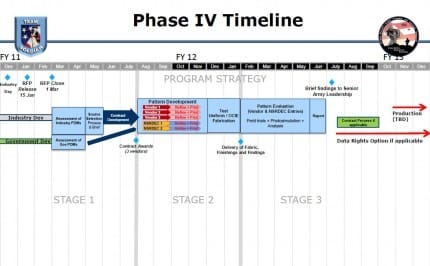
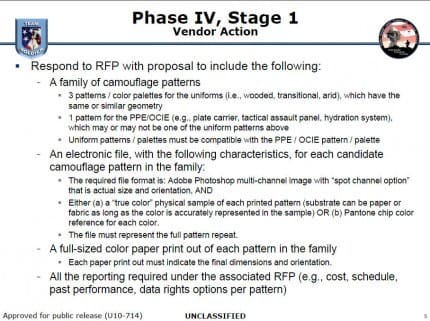
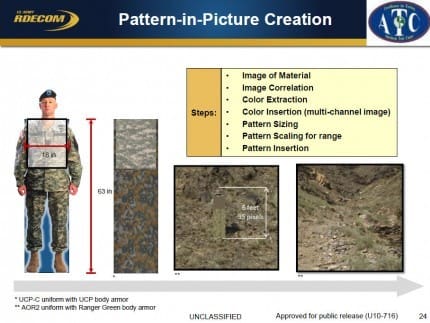
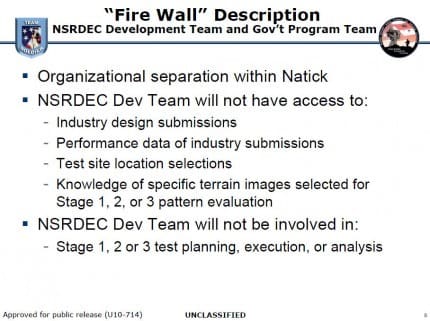
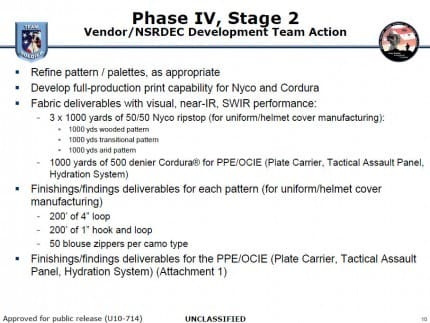
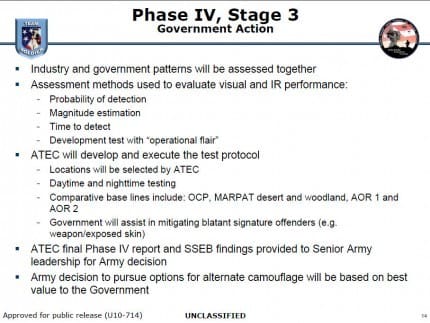
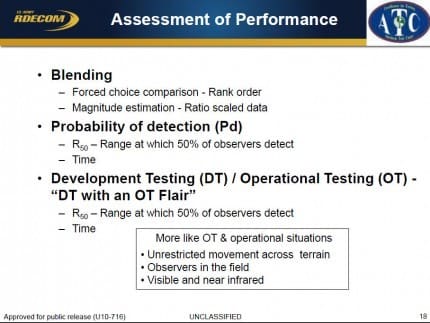
[…] Improvement Effort. According to the notice, the Army continues to seek out the same things; three patterns, ownership or the rights, yada, yada, yada. According to the notice, the actual solicitation will be released 18 March, 2011. Folks in […]
[…] those of you didn’t make it to the Army Camouflage Improvement Effort Industry Day last year, we thought we’d share a little tidbit with you that you would have missed. LTC Tim […]